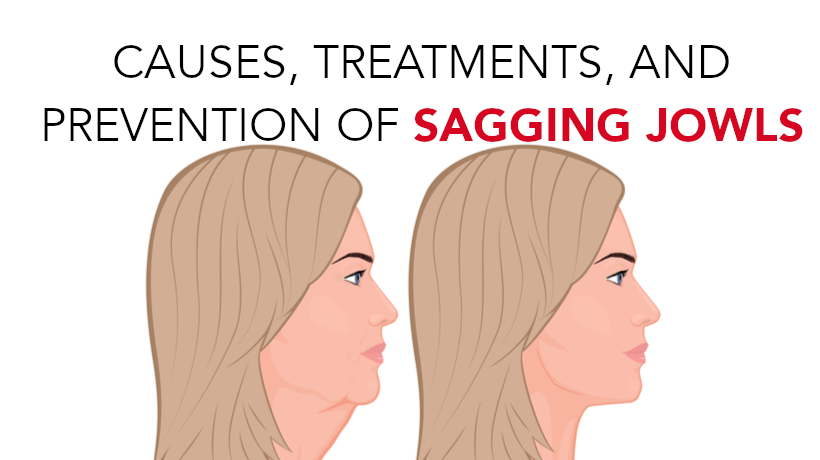Jowls are excess or saggy skin usually found below the jawline and the chin. One of the main causes of jowls is aging, though factors like genetics, stress, repetitive facial habits, and lifestyle choices can cause more pronounced jowls for anyone who has loose skin.
As humans age, the skin starts to lose some of its elasticity and collagen, which in turn, makes the skin dry, thin, and sag. Below we will review some common causes and treatments of jowls.
Causes of Jowls
The Sun & its UV Rays
Most people dream about going to the beach and sun tanning all day long with a margarita or an island drink in hand. While this sounds nice, it may cause you to have more pronounced jowls.
According to Oralift.com, a site founded by Dr. Nick Mohindra who specializes in dental facelifts, spending too much time in the sun can expose you to harmful UV rays. These UV rays help to break down the collagen in your skin faster, which is one of the reasons why jowls exist.
Mohindra recommends that “you limit your exposure to the sun, and always wear a moisturizer with SPF – even in the winter months.”
Smoking
Smoking doesn’t just damage your lungs. It can also cause jowls. According to Mohindra, smoking has a way of tightening your blood muscles, which ultimately means not enough blood flow and oxygen are reaching your face and skin. Smoking can also damage your body’s collagen and elastin production levels.
Technology
It may not seem like it, but technology can also cause jowls. This is partially due to the way we look at our screens. One of the most comfortable (but posture worsening) positions occurs when we bend our heads and stare down at our phones.
Mohindra says, “By bending our heads all day, we increase our chances of developing jowls and “tech neck” which causes back pain.”
Aging
While this isn’t something that we can control, aging is a common cause for jowls. Over time, our skin’s proteins that hold the skin together — collagen and elastin — break down. This leads to sagging.
“Once we hit 20, we produce about 1% less collagen a year, causing our skin to become thinner and more fragile,” Mohindra says.
Genetics
Once again, the factors that are out of our control are the most common causes of jowls! Argh! Depending on the skin type and facial structure that we have, Mohindra says, we are more likely to develop jowls.
Getting Rid of Jowls
Getting rid of jowls is not as hard as you think. In this section, solutions will be divided into two groups — surgical and non-surgical. Only you (and your doctor) will be able to know which is right for you.
Non-Surgical
Quit Smoking
If you are currently a smoker, the easiest way to reduce the appearance of jowls is to quit smoking. Easier said than done, obviously, but if you want to reduce the appearance of jowls, not smoking is the best solution.
Mohindra also adds, “And it’s not just sagging that smoking affects – the chances of skin cancer are increased by as much as 52% when you smoke, and skin conditions like psoriasis, acne inversa, vasculitis, and telangiectasia can be worsened.”
Wear Makeup
Makeup is a powerful tool, isn’t it? To reduce the appearance of jowls, you can simply find makeup that suits your needs.
Mohindra recommends buying a good quality moisturizer, a foundation that matches your skin tone, as well as buying a contour that is one to three shades darker than your skin.
“Blend downward to disguise your jowls and add highlights to draw the eye away from your jowls. YouTube is a great resource for tutorials.”
Face Yoga
While there still stands to be factual evidence for the efficiency of face yoga/face exercises with regard to reducing the appearance of jowls, some women have already raved about it.
Livestrong and Marie Claire have a few exercises you can do to reduce the appearance of jowls. Below is one exercise you can do, found on Livestrong.com.
Inhale with your mouth closed and fill your cheeks with air. Pass the air back and forth from cheek to cheek. When you’re out of breath, take another large inhale, and repeat.
Radiotherapy
Radiotherapy uses radiating heat to trick the collagen and elastin into producing more. The intense heat that is applied to the skin causes it to tighten since the collagen and elastin believes the skin has been damaged.
This therapy requires more than one session to complete but takes less than 30 minutes to do.
Most people do not need a recovery period for this, but radiotherapy has been known to cost upwards of $2,500.
Mohindra warns, “The risk of infection increases as you age.”
Surgical and Therapy Treatments
Fillers
“Fillers are compounds that are injected into the cheeks to fill in the places where fat has been lost from the skin,” says Deborah Weatherspoon, Ph.D., RN., CRNA.
Fillers can be injected directly into the problem area to make it appear fuller.
Many people find the results from facial fillers last anywhere between two and four years.
Depending on how severe your jowls are and how much they are lacking in collagen and elastin, the fillers usually last for a little while.
Neck Lift
This surgery requires you to go under the knife. The proper procedure for a neck lift occurs when a surgeon makes a cut along the side of the face and under the chin and will subsequently sculpt fat and tissues in the jaw and cheek. To finish, they may also cut excess skin and tighten the muscles around the problem area.
Neck lifts seem like the best option, but they are very expensive. Weatherspoon also warns, “Neck lifts are widely considered the most effective treatment for jowls, but the surgery has a long recovery time and carries the most significant risk of complications. The most common complications are scarring and infection.”
Ultherapy
This procedure uses “ultrasound therapy to stimulate the long-term production of collagen in the deep layers of the skin.”
Medical News Today has noted that most people do not need a recovery day and can return to their regular lives after having this procedure. One study saw improvements within three months.
Prevention
To prevent the severity of jowls, Weatherspoon of Medical News Today suggests:
- staying hydrated
- wearing sunscreen with UVA and UVB protection
- wearing protective clothing during periods of prolonged or intense sun exposure
- using moisturizers
- using creams and lotions high in antioxidants that promote the production of collagen, such as retinol (a type of vitamin A), vitamin C, and vitamin E
- avoiding habits and expressions that cause the jaw and cheek muscles to face downward, especially chewing gum, frowning, and using the computer for a long time
- eating a healthful diet
- exercising regularly
- not smoking
- sleeping on the back instead of the side or stomach
- doing facial exercises that promote flexible muscles in the entire face
Sources:



